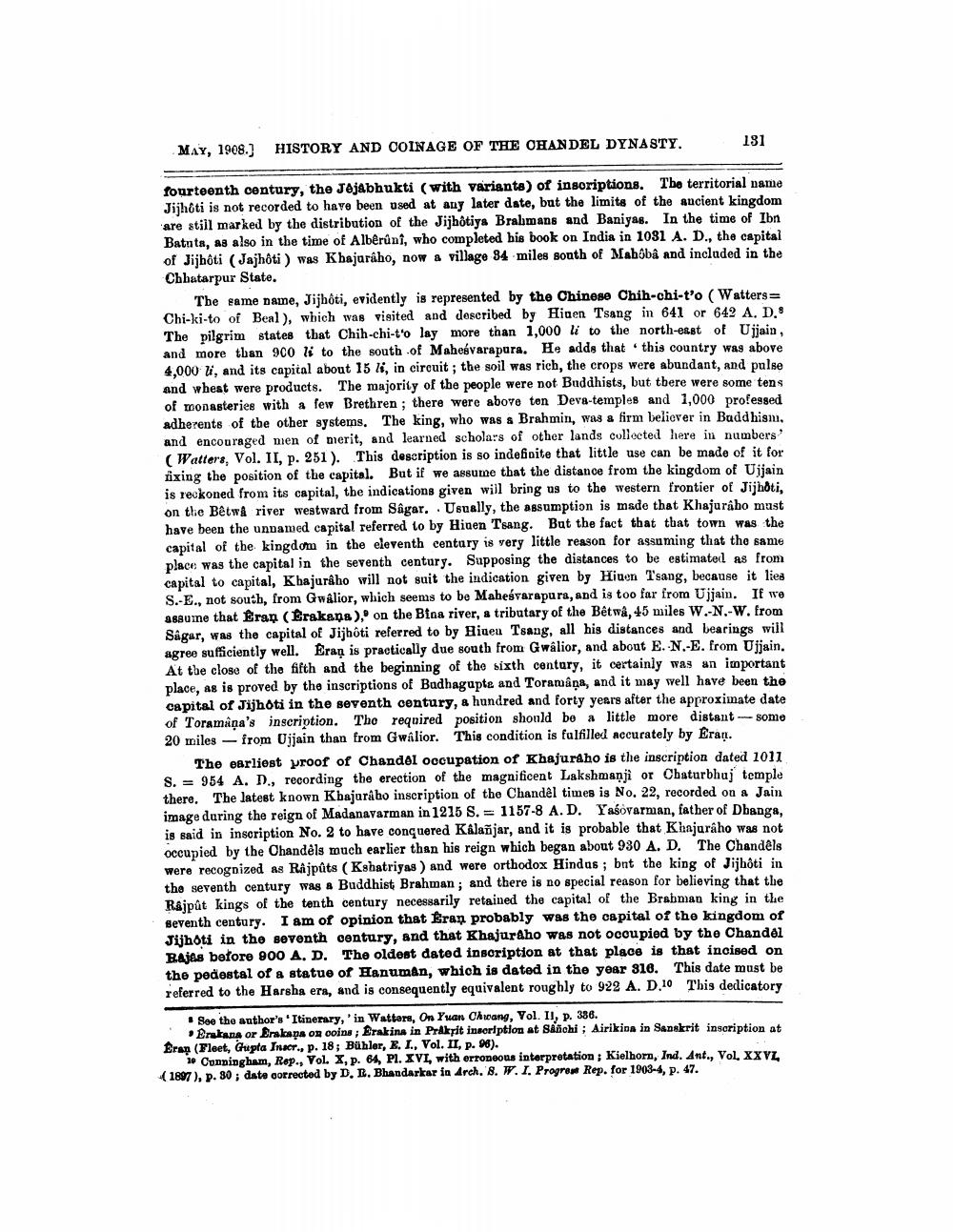________________
MAY, 1908.) HISTORY AND COINAGE OF THE CHANDEL DYNASTY.
131
fourteenth century, the Jejabhukti (with variante) of insoriptions. The territorial name Jijhoti is not recorded to have been used at any later date, but the limits of the ancient kingdom are still marked by the distribution of the Jijhotiys Brahmans and Baniyas. In the time of Ibn Batuta, as also in the time of Albêrûni, who completed his book on India in 1081 A. D., the capital of Jijhôti (Jajhôti) was Khajuraho, now a village 84 miles south of Mahobâ and included in the Chhatarpur State.
The same name, Jijhoti, evidently is represented by the Chinese Chih-chi-t'o (Watters = Chi-ki-to of Beal), which was visited and described by Hinen Tsang in 641 or 642 A. D. The pilgrim states that Chih-chi-to lay more than 1,000 li to the north-east of Ujjain, and more than 900 li to the south of Mahesvarapura. He adds that this country was above 4,000 li, and its capital about 15 li, in circuit; the soil was rich, the crops were abundant, and pulse and wheat were products. The majority of the people were not Buddhists, but there were some tens of monasteries with a few Brethren ; there were above ten Deva temples and 1,000 professed adherents of the other systems. The king, who was a Brahmin, was a firm believer in Buddhism, and encouraged men of merit, and learned scholars of other lands collected here in numbers (Watters, Vol. II, p. 251). This description is so indefinite that little use can be made of it for fixing the position of the capital. But if we assume that the distance from the kingdom of Ujjain is reckoned from its capital, the indications given will bring us to the western frontier of Jijhôti, on the Bêtwa river westward from Sagar. Usually, the assumption is made that Khajuraho must have been the unnamed capital referred to by Hinen Tsang. But the fact that that town was the capital of the kingdom in the eleventh century is very little reason for assuming that the same place was the capital in the seventh century. Supposing the distances to be estimated as from capital to capital, Khajuraho will not suit the indication given by Hinen Tsang, because it lies S.-E., not south, from Gwalior, which seems to be Maheśvarapura, and is too far from Ujjain. If we anaume that Eran (Erakana ),' on the Bina river, a tributary of the Bêtwå, 45 miles W.-N.-W. from Sagar, was the capital of Jijhôti referred to by Rigen Tsang, all his distances and bearings will agree sufficiently well. Eran is practically due south from Gwalior, and about E.-N.-E. from Ujjain. At the close of the fifth and the beginning of the sixth century, it certainly was an important place, as is proved by the inscriptions of Budhagapte and Toramâņa, and it may well have been the capital of Jijhoti in the seventh century, a hundred and forty years after the approximate date of Toramana's inscription. The required position should be a little more distant --some 20 miles from Ujjain than from Gwalior. This condition is fulfilled accurately by Erar.
The earliest proof of Chandel occupation of Khajuraho is the inscription dated 1011 S. = 954 A. D., recording the erection of the magnificent Lakshmanji or Chaturbhuj temple there. The latest known Khajuraho inscription of the Chandêl times is No. 22, recorded on a Jain image during the reign of Madanavarman in 1215 S. = 1157-8 A. D. Yašovarman, father of Dhanga, is said in inscription No. 2 to have conquered Kalañjar, and it is probable that Khajuraho was not occupied by the Chandels much earlier than his reign which began about 930 A. D. The Chandels were recognized as Rajpûts (Kshatriyas ) and were orthodox Hindus; bnt the king of Jijhôti in the seventh century was a Buddhist Brahman; and there is no special reason for believing that the Rajpût kings of the tenth century necessarily retained the capital of the Brabman king in the seventh century. I am of opinion that Bran probably was the capital of the kingdom of Jijhoti in the seventh century, and that Khajuraho was not occupied by the Chandel Bajes before 900 A. D. The oldest dated inscription at that place is that incised on the pedestal of a statue of Hanuman, which is dated in the year 810. This date must be referred to the Harsha era, and is consequently equivalent roughly to 922 A. D.10 This dedicatory
See the author's 'Itinerary, ' in Watters, On Yuan Cawang, Yol. II, p. 386.
Erukana or Erakana on coins ; Brakina in Prakfit inscription at Sanchi; Airikina in Sanskrit inscription at Erap (Fleet, Gupta Inscr., p. 18; Bühler, E.I., Vol. II, p. 28).
• Cunningham, Rep., Vol. X, p. 64, PL. XVI, with erroneous interpretation; Kielhorn, Ind. Ant., Vol. XXVL (1897), p. 80 ; dste corrected by D. L, Bhandarkar ia Arch. 8. W. I. Progrew Rep. for 1903-4, p. 47.




